 Want your audience to ask about your products?
Want your audience to ask about your products?
Wondering how to spark people's interest?
To explore how to use curiosity in your marketing, I interview Chalene Johnson.
More About This Show
The Social Media Marketing podcast is an on-demand talk radio show from Social Media Examiner. It's designed to help busy marketers, business owners, and creators discover what works with social media marketing.
In this episode, I interview Chalene Johnson. She's a marketer, speaker, and teacher. She's also the author of the book Push and founder of 131 Method, a site that helps people get healthy and lose weight in non-traditional ways.
Chalene explains how authentic connections and a little bit of mystery keep your audience interested in your content.
You'll also discover tips for creating cliffhanger content and answering people's questions.
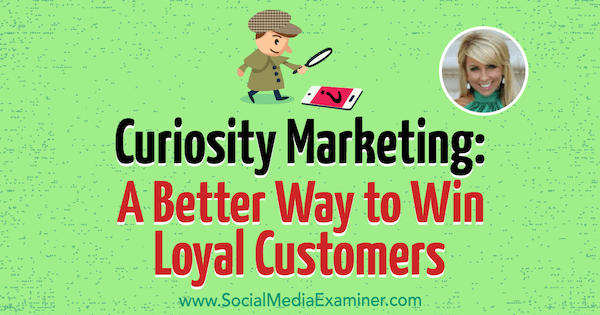
Share your feedback, read the show notes, and get the links mentioned in this episode below.
Listen Now
Where to subscribe: Apple Podcasts | Spotify | YouTube Music | YouTube | Amazon Music | RSS
Here are some of the things you'll discover in this show:
Curiosity Marketing
Chalene's Story
Most people know Chalene from her work in health and fitness. She's appeared in many infomercials and exercise DVDs. However, she's been successful in fitness because she loves business and helping people solve problems. In fact, Chalene has spent a large part of her professional life teaching people about marketing, building an online business, and developing passive income.
Chalene finds that marketers often copy other people who are successful (or assumed to be successful). But when you do that, you lose authenticity and fail to listen to yourself. You do things that don't come naturally to you and don't tune into what you like, what would grab your attention, and how you would like to be talked to.
When Chalene finds herself thinking she should do what her competitors are doing, she reminds herself of her passion for her own message and desire to serve others.
Get World-Class Marketing Training — All Year Long!
Are you facing doubt, uncertainty, or overwhelm? The Social Media Marketing Society can help.
Each month, you’ll receive training from trusted marketing experts, covering everything from AI to organic social marketing. When you join, you’ll also get immediate access to:
- A library of 100+ marketing trainings
- A community of like-minded marketers
- Monthly online community meetups
- Relevant news and trends updates
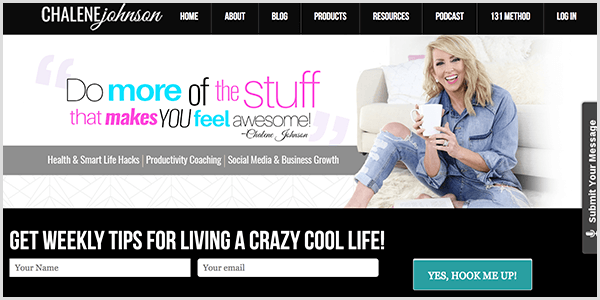
Also, you don't know the ins and outs of someone else's method. For instance, you don't know how big their team is, how much experience they have, how much traffic they receive, or what they want their lifestyle to look like.
Listen to the show to hear my thoughts on the problems with following someone else's playbook.
Why Is Curiosity a Powerful Concept?
People want to connect the dots, and when they can't, their curiosity is powerful and motivating. For example, when a child can't see what's under the bed, they imagine something's under there. In business, your goal is to get people's attention, maintain it, and engage with them. Curiosity can help you accomplish those goals.
Nowhere is keeping people's attention more challenging than on TV, where you see shows like Storage Wars pique viewers' curiosity before cutting to a commercial. Storage Wars is a cable TV show where abandoned storage units are auctioned off. Sometimes they're filled with nothing; sometimes they're filled with amazing treasures.
To keep you engaged, just before the show cuts to commercial, the door on the storage unit slides up so you can glimpse inside. Then you're left wondering, “Was the unit a bust or was there something valuable in it?” Chalene thinks it's important to translate this tactic to marketing to keep people's attention. The longer you have someone's attention, the more likely you are to build trust.
Listen to the show to hear my thoughts on cliffhangers.
Chalene's Strategy
Chalene's strategy for curiosity marketing is built on authenticity, growing your community, and asking questions. To make these concepts easy to remember, she has a phrase for each part of her strategy.

Borrowed Words Are for the Birds: When the language in your copy or social media video uses someone else's language, your words don't feel authentic. Only the words that you use feel natural. When someone's being inauthentic or they're uncomfortable, it's so easy to identify. This comes across especially on video, even if viewers register the effect only on a subconscious level.
Also, authenticity has leveled the playing field for the person who doesn't have Hollywood looks and isn't incredibly articulate on camera. People trust someone who seems more like their neighbor.
To illustrate, when Chalene created an infomercial for PiYo, she partnered with Beachbody, which hired a celebrity spokesperson, a scriptwriting company, and a studio audience that clapped and applauded to create the appearance of being on a TV show talking about PiYo. Chalene talked to the camera only briefly, and when she did, she read someone else's words from a teleprompter.
This infomercial didn't do well. After a year of testing, the PiYo infomercial never did more than break even. When CEO Carl Daikeler told Chalene that Beachbody was done investing in the infomercial, she asked to create an infomercial using her words. Carl agreed but said he needed the ad in 2 weeks.
Chalene filmed the PiYo infomercial herself using her iPhone. She knew exactly who the customer was, what she needed to hear, and how to talk to her. Instead of using a script or hair and makeup, Chalene held up her iPhone and talked to her customer in authentic words about how the customer was feeling and why the PiYo program was created for her.
After Chalene and Beachbody tested that infomercial about a month later, it held the number-one spot for the majority of the year. In fact, it was the infomercial of the year last year and is still performing well. Because Chalene filmed the infomercial on the wrong settings, it's completely grainy, but it performs well because it's authentic.
This authenticity is important because marketers are competing for the same audience. However, the audience has almost become jaded by marketing techniques and tactics. Everyone wants to avoid being scammed, taken advantage of, or bamboozled. Your audience needs to trust you to feel in charge of their own destiny.
In fact, right before this podcast, Chalene met with a group that does Facebook ads. They were talking about the fact that native social videos turned into ads outperform everything right now. In other words, the person in the video doesn't even know the video will be an ad. But because they're speaking passionately about their topic, their video ends up being the best content.
On social media, Chalene can tell when someone's delivery is perfect and contrived, and they're searching for the right word or reading from a script on a podcast. She doesn't buy it, believe it, like it, or relate to it.
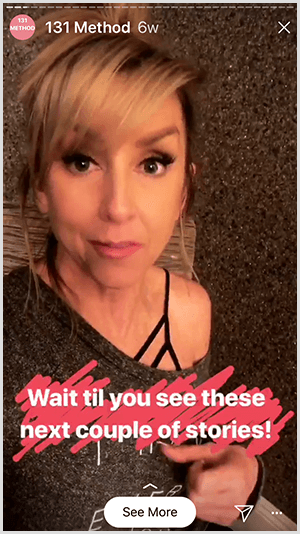
To avoid this problem while recording video for the PiYo infomercial, Chalene pretended to talk to her Aunt Nellie, who isn't judgmental and loves how quirky and funny Chalene is. If you're nervous, you can use Snapchat and Instagram Stories to help you practice the 10-second soundbite. The more often you do it, the better you get.
Chalene also finds that most people fear the comments. In this case, she recommends turning off the comments until you feel comfortable. Or think of comments as evidence that you have viewers. Also, remember that the more viewers you get, the more weird and obscure the comments will be. That's just proof that people are watching.
Don't Tell Me You Plan to Sell to Me: Right now, a big mistake marketers make is obviously gearing up for the sale. Or the sale is the first thing that viewers see because marketers lead with their product, disappear, and then suddenly return to the news feed for another a launch or promotion. With this approach, you're like a fair-weather friend. To keep your audience's attention, be consistent.
Marketers also tell their audience they plan to sell when they put all their products in their bio or use their product or service name as their handle. Chalene often sees small business owners make this mistake.
Say someone's interested in the makeup line you represent. If your audience loves the way your makeup looks but already knows the company you represent, they're going to Google it and buy the makeup from your competitor or read negative reviews that aren't appropriate or authentic. So if you share the company and product names, you lose control of that relationship.
A better idea is getting your audience to ask, “What brand of makeup do you wear?” Then you have a relationship. Also, in your bio, it's better to talk about your interest such as beauty, fitness, or whatever topic best describes your content.
Also, this tactic doesn't work in every situation. You don't necessarily need to remove your domain name from your bio. In most instances, you can send people to the link in your bio. However, if you're in a competitive market where lots of people offer the same product or service, Chalene recommends sharing your email address so people can reach out to you.
Before you start pitching your product or service, you need to have a relationship with your audience. Someone who's had a conversation with you is more likely to check out your website. Although building relationships and having conversations take more time, that's how social media works right now. People crave real conversations and attention from the person they're watching.

For example, when your favorite broadcaster goes live and the live notification appears, you want to jump on the live video. Although you could watch the video anytime you want, you watch the live video because you want that broadcaster to notice you. Curiosity marketing validates your potential customers better than any other type of marketing. It says, “I see you, I hear you, I'm listening to you, I'm talking to you.” That connection is powerful.
I add that creating authentic content and getting to know your tribe are important because people are more sophisticated now and know when you're selling to them. Also, algorithms are there to prevent you from creating salesy marketing content without paying for it. In a world of marketers signaling when they're going to sell, the ones who don't look like marketers are the ones who'll succeed.
 Chalene agrees and explains how you can generate sales without making a sales pitch. Piquing people's curiosity is important. When you create a gap that people want to fill, they'll decide for themselves to ask an additional question or log on the next time you're live. The same gap makes people curious enough to stay through the commercial.
Chalene agrees and explains how you can generate sales without making a sales pitch. Piquing people's curiosity is important. When you create a gap that people want to fill, they'll decide for themselves to ask an additional question or log on the next time you're live. The same gap makes people curious enough to stay through the commercial.
To illustrate, if you share your journey of creating a new product or event that you want people to attend, you give people a lot of the information. It's exciting, and they know it's something different but don't know what it is. It's like teasing your product without being too obvious.
Chalene might say, “I'm working on something really exciting. I wish I could tell you.” Or, “the new event that we're putting together is mind-blowing, and people are getting great results. We're scheduled in July.” This way, you're also giving your audience lots of information.
Chalene initially discovered the power of this approach by accident. While she was Snapchatting, a technical glitch failed to post the last four videos in a series.

Discover Proven Marketing Strategies and Tips
Want to go even deeper with your marketing? Check out the Social Media Marketing Podcast! Publishing weekly since 2012, the Social Media Marketing Podcast helps you navigate the constantly changing marketing jungle, with expert interviews from marketing pros.
But don’t let the name fool you. This show is about a lot more than just social media marketing. With over 600 episodes and millions of downloads each year, this show has been a trusted source for marketers for well over a decade.
The next morning, she woke up to endless comments asking about the event and how to get more details.
Likes Wear Thin; Questions for the Win: When you're creating content, focus on what will make people curious or intrigued 80% of the time. Your goal is for your audience to ask questions and engage in meaningful conversation. Don't worry about likes or shares.
For instance, Chalene saw a woman post a photo of herself in a really cute workout outfit. Her body looked amazing, and in her post, she wrote about how she had transformed her body. She included details about the program she used, how long it lasted, and how people could click the link in her bio to purchase it.
Below this attention-grabbing image, people asked hundreds of questions about her outfit. Her audience didn't ask about the workout program because she didn't create curiosity about it. To generate curiosity, the woman could have shared how much her outfit cost and where she got it. Then she could explain how her workout helped her gain confidence to buy the outfit and didn't hurt her joints.
With this approach, no one will ask about the outfit. Instead, they'll ask the right questions. In this example, Chalene wouldn't even say, “Hit me up if you have any questions.”
I ask Chalene to talk about what it means for likes to wear thin. Chalene says that when you're developing your own social media strategies, always ask yourself whether the strategy you're using would work for you, personally. The approach that would work for you is what will work for your tribe, the people you're trying to attract.
With this point in mind, Chalene notes that if likes are your measure of success, you're going to be disappointed because people are clicking Like less frequently. If you look at your own behavior, you can see why: everyone is following a lot of people, and clicking Like is an extra step. After you swipe through a carousel of photos on Facebook or on Instagram, you'll move on and forget to tap Like.
So likes don't tell you who's curious. Likes tell you people gave you an obligatory tap, and obligatory taps don't pay the mortgage. Relationships are how you change the world, serve other people, and sell more.

I ask Chalene to share how she keeps people curious and asking questions, using her 131 Method as an example. Chalene says for a program like 131 Method, people are curious about what you're eating, why, and how. If Chalene says the program is about “clean” eating, people will want to know what that means; they might ask whether the diet is plant-based.
With this technique, you need to provide enough information so your audience can follow along but not so much that they don't have any gaps. When we don't know anything, we're not curious. When we know a little about something, we're curious. When we know everything, we're not curious. Your audience won't need to ask questions or follow you anymore. They come to their own conclusions.
Chalene recommends being thoughtful about what you want to discuss in your next post or live video. She intentionally leaves pieces out because she wants you to be curious. In other words, she doesn't flood her audience with a fire hose of information. Instead, she drips it out to keep people engaged.
You can also simply be a little bit vague. Leave out the things you would like people to ask you about because that creates an opportunity to connect. If you create content that documents your day, create some interest by leaving out some details while still letting your audience follow the journey.
Over the last 2 years, Chalene has shared what she's learning and why she's passionate about it, and has given people enough information to make them curious. She might share people's testimonials or how a person who struggled with Hashimoto's disease and weight loss resistance lost weight after learning how to diet phase.
Diet phasing is what the 131 Method teaches, but Chalene won't mention that part. However, she does include the phrase “diet phasing,” which most people aren't familiar with.

I mention that a book I wrote in my copywriting days, Writing White Papers, talked about making up a phrase that may become an industry maxim eventually and that has some intuitive meaning. Later, when you talk about what to look for in a specialist, you can mention that phrase.
Chalene says after she had that experience of waking up to bajillions of questions, she started wondering how that happened and why there was so much curiosity. Right away, her questions led her to the great copywriting experts. She found that copywriters have been generating curiosity forever. They're really good at it.
For example, in the P90X infomercial, the phrase used to describe the secret to P90X was “muscle confusion.” It makes people curious because they know what muscles are and what confusion is, but what the heck is muscle confusion? Don't be afraid to use words that people can understand a little bit but want to know more about.

A really simple way to keep people curious is to take them on a journey where they want to know how it turns out. You're not trying to sell anything. You just want to keep people's attention. For instance, Chalene recently suffered a hamstring avulsion, where the hamstring muscles were torn 17 millimeters from the pelvic bone.
The orthopedic surgeon told Chalene she was on the cusp but would need to have the hamstring surgically reattached. Another expert who knew Chalene's background and what she's into said, if she wasn't opposed, they could try an alternative healing process.
Chalene loved the idea and has been taking her social media family on this journey by sharing all the things she's doing and her progress. They're staying tuned to see whether the alternative method works or if she'll need to have surgery. It's a nice outlet for Chalene and also keeps her audience involved. Every day, she receives a message asking for an update.
The main takeaway is to focus on how you can keep people's attention longer. Don't think about selling something but instead about how to keep people engaged. That's the win. Your audience needs to have a relationship with you. If you have that relationship, they trust you and will sign up for your offer.
Listen to the show to hear my thoughts about being authentic and how live video can help.
Tips for Keeping Your Audience Curious
A cliffhanger is a simple way to keep your audience curious. To illustrate how this works, Chalene makes up an example. If she was really excited about a new supplement from her doctor that's supposed to promote cellular regeneration, she might share that she's going to get a treatment right now and will let you know how she feels when she's done.
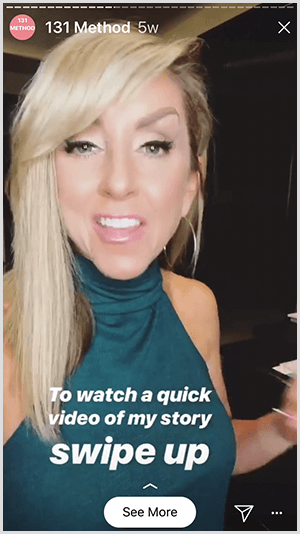 Then, Chalene will intentionally wait until the next day to post an update. When people start asking for an update, you know people are paying attention. It's almost like gamification. A lot of websites and social media platforms like Fitbit and Facebook spend a boatload of money trying to figure out how to keep us coming back. Marketers need to do the same thing.
Then, Chalene will intentionally wait until the next day to post an update. When people start asking for an update, you know people are paying attention. It's almost like gamification. A lot of websites and social media platforms like Fitbit and Facebook spend a boatload of money trying to figure out how to keep us coming back. Marketers need to do the same thing.
You can create short little updates in many different ways. For instance, you could use Facebook or Instagram Stories, a static photo, videos, and so on. On Pinterest, when you click an infographic and then want to see the rest of the story or other tips, the platform takes you back to the original poster's website. Short updates are similar because they leave your audience wanting more information.
Although you might be afraid of how much time this level of interaction will take, Chalene emphasizes that it's worth that time. To scale with this approach, Chalene created text replacements on her iPhone.
As an example, Chalene was talking to people on Snapchat about the Marketing Impact Academy. It was her biggest-ever launch of a $2,000 program. Although Snapchat is her smallest platform, she had the biggest return on investment there because she used this process.
When someone asked a question, Chalene used a text replacement function on her iPhone that turned her shorthand into everything she wanted to share with them. You can turn OMW into the text “on my way.” Similarly, you can tell your smartphone to turn a letter sequence like MIA into a long message that answers a common question.
To find this feature on an iPhone, tap Settings, General, Keyboard, and then Text Replacement. Android phones have a similar feature.
Chalene uses text replacements to interact with everyone she can every single day on Instagram and Snapchat. Without text replacement, that could take a lot of time. However, she can write four or five sentences by simply typing two letters. People wonder if it's really her, or they're impressed she takes the time to answer their question.
Whenever Chalene posts content and knows people are going to ask where she got something and how much it cost, she simply creates a little abbreviation that writes a paragraph. Then she can reply to each person in detail. You develop a great sense of appreciation and reciprocity when you communicate with your audience that way.
Listen to the show to hear more about how Chalene uses text abbreviations.
Discovery of the Week
Smart Compose is a cool new feature inside the brand-new Gmail.
With Smart Compose, Gmail predicts what you'll type and gives you suggestions to help you finish your email quicker. For example, after you add your recipient's email address, Smart Compose might suggest a subject based on subjects you often use for that recipient. To accept a Smart Compose suggestion, you simply press Tab.
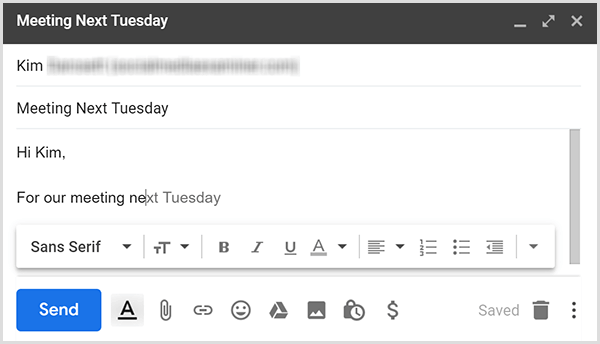
The meeting scheduling capability also works well. In the body of the email, you might mention scheduling a meeting, and Smart Compose will suggest next week. You might write, “Are there times,” and then Smart Compose will suggest, “that work best for you?” You can continue to press Tab to fill out the email. The process works pretty seamlessly.
To use Smart Compose, you need to have the new Gmail and turn on experimental features. To switch to the new Gmail, you click the gear-shaped Settings icon in the upper right and select the option to try the new Gmail. For a corporate account, the administrator of your account needs to activate the new Gmail so that all the people who work for the company can access this option.
To turn on experimental features, click the Settings icon, select Settings from the menu that appears, and then select the Enable Experimental Access option.
Smart Compose is available when you access Gmail in a desktop browser such as Chrome, Firefox, or Safari.
Listen to the show to learn more about Smart Compose and let us know how it works for you.
Key takeaways from this episode:
- Visit Chalene's website.
- Learn about the 131 Method diet.
- Read her book, Push.
- Follow ChaleneOfficial on Snapchat.
- Check out episodes of Storage Wars.
- Watch the PiYo infomercial Chalene filmed herself.
- Learn about the Marketing Impact Academy.
- Write emails in Gmail with Smart Compose.
- Watch our weekly Social Media Marketing Talk Show on Fridays at 10 AM Pacific on Crowdcast or tune in on Facebook Live.
- Attend the Facebook Ads Summit.
- Download the 2018 Social Media Marketing Industry Report.
Help Us Spread the Word! Please let your Twitter followers know about this podcast. Simply click here now to post a tweet.
If you enjoyed this episode of the Social Media Marketing podcast, please head over to iTunes, leave a rating, write a review, and subscribe. And if you listen on Stitcher, please click here to rate and review this show.
What do you think? What are your thoughts on curiosity marketing? Please share your comments below.
Attention Agency Owners, Brand Marketers, and Consultants

Introducing the Marketing Agency Show–our newest podcast designed to explore the struggles of agency marketers.
Join show host and agency owner, Brooke Sellas, as she interviews agency marketers and digs deep into their biggest challenges. Explore topics like navigating rough economic times, leveraging AI, service diversification, client acquisition, and much more.
Just pull up your favorite podcast app, search for Marketing Agency Show and start listening. Or click the button below for more information.

